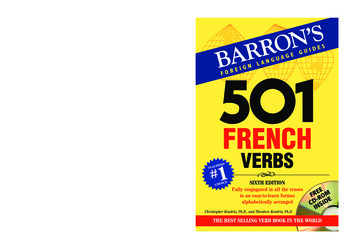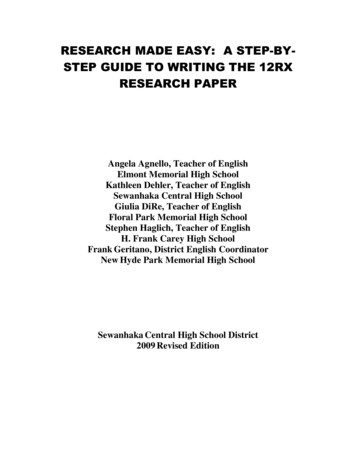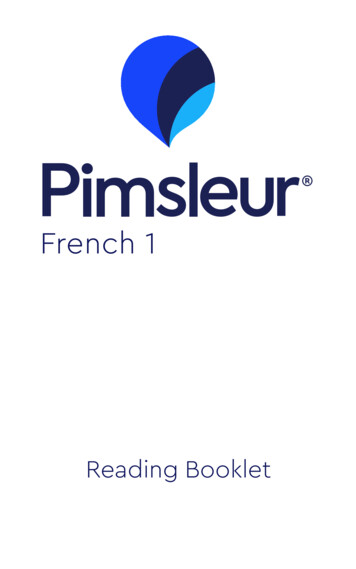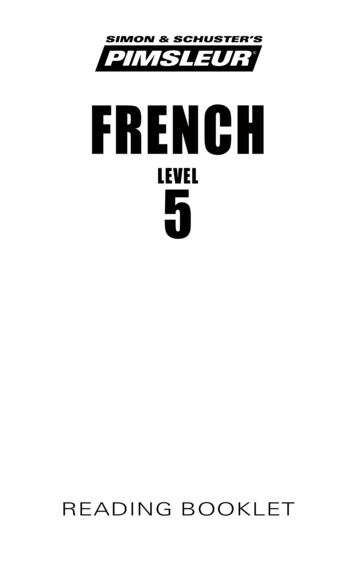
Transcription
Easy FrenchSTEP-BY-STEPMaster High-Frequency Grammarfor French Proficiency—FAST!Myrna Bell RochesterNew York Chicago San Francisco Lisbon London Madrid Mexico CityMilan New Delhi San Juan Seoul Singapore Sydney Toronto
Copyright 2009 by The McGraw-Hill Companies, Inc. All rights reserved. Except as permitted under the United StatesCopyright Act of 1976, no part of this publication may be reproduced or distributed in any form or by any means, orstored in a database or retrieval system, without the prior written permission of the publisher.ISBN: 978-0-07-164221-7MHID: 0-07-164221-8The material in this eBook also appears in the print version of this title: ISBN: 978-0-07-145387-5, MHID: 0-07-145387-3.All trademarks are trademarks of their respective owners. Rather than put a trademark symbol after every occurrence ofa trademarked name, we use names in an editorial fashion only, and to the benefit of the trademark owner, with nointention of infringement of the trademark. Where such designations appear in this book, they have been printed withinitial caps.McGraw-Hill eBooks are available at special quantity discounts to use as premiums and sales promotions, or for use incorporate training programs. To contact a representative please visit the Contact Us page at www.mhprofessional.com.TERMS OF USEThis is a copyrighted work and The McGraw-Hill Companies, Inc. (“McGraw-Hill”) and its licensors reserve all rightsin and to the work. Use of this work is subject to these terms. Except as permitted under the Copyright Act of 1976 andthe right to store and retrieve one copy of the work, you may not decompile, disassemble, reverse engineer, reproduce,modify, create derivative works based upon, transmit, distribute, disseminate, sell, publish or sublicense the work or anypart of it without McGraw-Hill’s prior consent. You may use the work for your own noncommercial and personal use; anyother use of the work is strictly prohibited. Your right to use the work may be terminated if you fail to comply with theseterms.THE WORK IS PROVIDED “AS IS.” McGRAW-HILL AND ITS LICENSORS MAKE NO GUARANTEES OR WARRANTIES AS TO THE ACCURACY, ADEQUACY OR COMPLETENESS OF OR RESULTS TO BE OBTAINEDFROM USING THE WORK, INCLUDING ANY INFORMATION THAT CAN BE ACCESSED THROUGH THEWORK VIA HYPERLINK OR OTHERWISE, AND EXPRESSLY DISCLAIM ANY WARRANTY, EXPRESS ORIMPLIED, INCLUDING BUT NOT LIMITED TO IMPLIED WARRANTIES OF MERCHANTABILITY OR FITNESSFOR A PARTICULAR PURPOSE. McGraw-Hill and its licensors do not warrant or guarantee that the functions contained in the work will meet your requirements or that its operation will be uninterrupted or error free. Neither McGrawHill nor its licensors shall be liable to you or anyone else for any inaccuracy, error or omission, regardless of cause, inthe work or for any damages resulting therefrom. McGraw-Hill has no responsibility for the content of any informationaccessed through the work. Under no circumstances shall McGraw-Hill and/or its licensors be liable for any indirect,incidental, special, punitive, consequential or similar damages that result from the use of or inability to use the work, evenif any of them has been advised of the possibility of such damages. This limitation of liability shall apply to any claimor cause whatsoever whether such claim or cause arises in contract, tort or otherwise.
ContentsPrefaceIxiFirst Elements of French1 Nouns, Articles, and Descriptive AdjectivesGender and Number of Nouns and Articles 3The Definite Article 3Masculine Nouns 3Feminine Nouns 4Masculine and Feminine Articles Before a Vowel Sound or Mute hSingular Nouns and the Definite Article 5Learning the Gender of Nouns 5The Indefinite Article 7Masculine Nouns 8Feminine Nouns 8Plural Nouns 8Pronouncing the Plural 9Descriptive Adjectives 11Agreement of Adjectives in Gender and Number 12Adjectives of Color 14Adjectives That Precede the Noun 14Key Vocabulary 16Les adjectifs descriptifs (Descriptive Adjectives) 16Les couleurs (Colors) 16Key Vocabulary 18Les nationalités (Nationalities) 18iii43
ivContents2 The Verbs être and avoir,Subject Pronouns, and Negation21The Verb 21The Verbs être (to be) and avoir (to have) 21Être and Subject Pronouns 22Subject Pronouns 22Uses of être 26Expressions with être 29Key Vocabulary 30Conjonctions, qualificatifs, et adverbes(Conjunctions, Qualifiers, and Adverbs) 30Negation with ne. pas 31The Verb avoir (to have) 32Ne. pas de. with avoir 33Il y a. (There is . . . , There are . . . ) 33Expressions with avoir 35Key Vocabulary 38La maison (The House) 38Reading Comprehension: La maison de Jean-Pierre 403 Days and Months, Regular -er Verbsin the Present Tense, and InterrogativesDays of the Week, Months, and Seasons 42Les jours de la semaine (Days of the Week) 42Les mois de l’année (Months of the Year) 43Les saisons (Seasons) 43Les parties du jour (Parts of the Day) 44Regular Verbs in the Present Tense 45Conjugating Regular -er Verbs 45Uses of the Present Tense 48Interrogatives and Interrogative Words 52Yes/No Questions 53Information Questions 57Key Vocabulary 62Noms masculins (Masculine Nouns) 62Noms féminins (Feminine Nouns) 63Adjectifs (Adjectives) 63Conjonctions (Conjunctions) 64Reading Comprehension: Une petite ville en province 644 Numbers, Dates, and Time andRegular -ir Verbs in the Present TenseCardinal Numbers 66Numbers from 0 to 99 66Numbers from 100 696642
vContentsOrdinal Numbers 70The Date and the Year 72Telling Time 75Regular -ir Verbs in the Present Tense 78Key Vocabulary 82Les magasins et les commerces (Stores and Businesses)Key Vocabulary 83Les repas et les provisions (Meals and Groceries) 83Reading Comprehension: Au restaurant 85825 Regular -re Verbs in the Present Tenseand -er Verbs with Spelling Changes 87Regular -re Verbs in the Present Tense 87Key Vocabulary 90Expressions de temps (Expressions of Frequency and Time) 90Depuis Versus Since 91-er Verbs with Spelling Changes 93Verbs like commencer (to begin) 93Verbs like manger (to eat) 94Verbs like acheter (to buy) 96Verbs like préférer (to prefer) 98Verbs like appeler (to call; to name) and jeter (to throw [away]) 100Verbs like envoyer (to send) and essayer (to try) 101Key Vocabulary 104Les vêtements et les accessoires (Clothing and Accessories) 104Articles de toilette (Toiletries) 105Reading Comprehension: En ville 1076 Expressing the Future with aller,Prepositions, and the Verb faire 109The Verb aller (to go) 109Expressing the Future with aller 110Key Vocabulary 111Alors, quand vas-tu. ? (So, when are you going to . . . ?)À, de, and Other Prepositions 113The Prepositions à and de 114Prepositions of Location 118Prepositions of Time and Sequence 119Interrogatives with Prepositions 122Qui and quoi in a Question After Prepositions 122The Interrogative Pronoun lequel 122Key Vocabulary 124Des pays du monde (Some Nations of the World) 124Prepositions with Geographical Names 125Gender of Geographical Names 125To, in, and from with Geographical Names 126111
viContentsThe Verb faire (to do; to make) 129The Weather, Day, and Night 129Idioms with the Verb faire 130Key Vocabulary 135Le temps et l’environnement (Weather and the Environment)Reading Comprehension: Des projets de vacances 1367 Irregular Verbs I andVerb Verb Constructions135138Learning Irregular Verbs 138Verbs like partir (to leave, depart) 138Partir, sortir, and quitter 139Verbs like venir (to come; to arrive) 140Special Uses of venir and tenir 141Dire (to say, tell), lire (to read), and écrire (to write) 143Verbs like mettre (to put [on], place) 145Pouvoir (to be able to) and vouloir (to want to, wish to) 147The Verb devoir (to have to; to owe) 148Verbs like recevoir (to receive; to have guests) 150Verb Verb Constructions 152Verbs with No Intervening Preposition 153Verbs Requiring à Before the Infinitive 153Verbs Requiring de/d’ Before the Infinitive 154Key Vocabulary 157Lire et écrire (Reading and Writing) 157Reading Comprehension: Mes décisions 1588 Irregular Verbs II and Relative Pronouns161Connaître (to know, be acquainted with) Versus savoir (to know [facts])Uses of connaître and savoir 162Voir (to see) and croire (to believe) 165Courir (to run) and rire (to laugh) 166The Group offrir (to offer) 167The Group conduire (to drive; to lead) 169Suivre (to follow; to take a course) and vivre (to live) 169The Group craindre (to be afraid of) 170Relative Pronouns: qui, que, où, dont, and lequel 173Que, qui, and où 173Relative Pronouns with Prepositions; lequel and dont 177Indefinite Relative Pronouns: Statements from Questions 180Key Vocabulary 182Les métiers et les professions (Jobs and Professions) 182Reading Comprehension: Une nouvelle carrière 184161
Contents9 Prendre and boire, the PartitiveArticle, and Object Pronouns 186The Group prendre and the Verb boire 186The Partitive Article 189Uses of the Partitive Article 189Direct Objects 193Forms and Placement of Direct Object Pronouns 193Indirect Objects 196Indirect Object Pronouns 197The Pronouns y and en 199The Pronoun y 199The Pronoun en 200Key Vocabulary 204Les animaux (Animals) 204Les plantes (Plants) 204Reading Comprehension: Le jardin zoologique idéal 20510 Possessives, Demonstratives,Comparatives, and Adverbs 208Possessive Adjectives and Pronouns 208Possessive Adjectives 208Possessive Pronouns 210Demonstrative Adjectives and Pronouns 212Demonstrative Adjectives 212Demonstrative Pronouns 213Comparatives and Superlatives 216The Comparative with Adjectives 216The Comparative with Nouns 216Comparing Verbs 217The Superlative of Adjectives and Nouns 218Irregular Comparative and Superlative Adjectives 219Adverbs 221Common Adverbs and Their Placement 221Formation of Adverbs with -ment 222Comparatives and Superlatives of Adverbs 224Key Vocabulary 226Adverbes (Adverbs) 226Key Vocabulary 227Les membres de la famille (Family Members) 227Reading Comprehension: La famille française moderne 229vii
viiiContentsIIAffirmative and Negative Expressions,Forming the Imperative, and UsingPronominal Verbs11 Affirmatives Versus Negatives,Stressed Pronouns, and the Imperative232More Ways to Say Yes and No 232Stressed Pronouns 238Uses of Stressed Pronouns 238The Imperative and Its Forms 242The Imperative of -er Verbs 242The Imperative of -ir Verbs 243The Imperative of -re Verbs 243Imperative Forms of Irregular Verbs 244Negative Commands 245The Imperative in Sentences 245The Imperative with an Object Pronoun 246Key Vocabulary 249L’entretien de la maison et du jardin (House and Garden Maintenance)Le bricolage (Do-It-Yourself Projects) 250Reading Comprehension: Un week-end de bricolage 25112 Reflexive Pronouns with PronominalVerbs and the Present Participle 253What Is a Pronominal Verb? 253Reflexive Verbs 254Key Vocabulary 254La vie quotidienne (Everyday Routines) 254Pronominal Verbs in Infinitive Constructions 255Pronominal Verbs: Negative, Interrogative, and Imperative Forms 257Negatives of Pronominal Verbs 257Interrogatives of Proniminal Verbs 258Imperatives of Pronominal Verbs 258Reflexive Verbs with Parts of the Body 261Reciprocal Reflexive Verbs 262Idiomatic Pronominal Verbs 265Non-Pronominal Forms of Pronominal Verbs 268The Present Participle 270Formation of the Present Participle 270Uses of the Present Participle 271Key Vocabulary 273Les parties du corps (Parts of the Body) 273Reading Comprehension: Un accueil chaleureux? 274249
ixContentsIIIThe Past and Future Tenses, theConditional, and the Subjunctive Mood13 Forms and Uses of the passé composé278What Is the passé composé? 278Formation of the passé composé with avoir 278Regular and Irregular Past Participles 279Regular Past Participles 279Irregular Past Participles 281Negatives, Interrogatives, and Adverbs with the passé composé 284The passé composé in the Negative 284The Interrogative of the passé composé 284Adverbs with the passé composé 284Key Vocabulary 285Expressions de transition (Transition Words) 285The passé composé with être 288The passé composé with Object Pronouns 291Agreement of Object Pronouns with the Past Participle 291The passé composé of Pronominal Verbs 292When the Past Participle Does Not Agree 293Key Vocabulary 294Le sport (Sports) 294Les distractions (Leisure and Entertainment) 295Reading Comprehension: Une soirée mouvementée 29714 The imparfait, Past Narration,and More About Object Pronouns299Summary of the passé composé 299The imparfait (Imperfect Tense) 301Forms of the imparfait 301Meanings and Uses of the imparfait 302Key Vocabulary 305Expressions de temps au passé (Expressions of Time in the Past)Narration: The passé composé and the imparfait Used Together 306More About Object Pronouns 309Double Object Pronouns 309Double Object Pronouns with Affirmative Imperatives 310Key Vocabulary 312Les voyages et le logement (Travel and Lodgings) 312Reading Comprehension: Un voyage mémorable 314305
xContents15 The Future Tense, the Conditional,and Indefinite Adjectives and Pronouns315The Future Tense 315Irregular Forms of the Future Tense 316Uses of the Future Tense 317The Conditional 319Uses of the Conditional 321The Pluperfect and the Past Conditional 323The Pluperfect 323The Past Conditional 324Tout and Other Indefinite Adjectives and Pronouns 326Forms and Uses of tout 326Other Indefinite Adjectives and Pronouns 328Key Vocabulary 330À la banque (Business and Banking) 330Reading Comprehension: Rêves d’avenir 33216 The Subjunctive334The Subjunctive Mood 334Forms of the Present Subjunctive 335Irregular Subjunctives 336Seven More Irregular Subjunctive Forms 337Uses of the Subjunctive 339The Subjunctive with Expressions of Necessity 339The Subjunctive with Other Impersonal Expressions 340The Subjunctive with Personal Expressions of Volition, Emotion, and DoubtKey Vocabulary 347Liens d’amitié (Friendship Ties) 347Reading Comprehension: Créer des liens 349Answer KeyIndex375351343
PrefaceEasy French Step-by-Step will help you learn the basics of French—forspeaking, reading, and writing—as quickly and as thoroughly as possible.Prepared for beginners and advanced beginners, this book teaches Frenchgrammar and natural, everyday speech in logical order to enable you todevelop and build on your language skills.To take full advantage of the grammatical progression of this book, you’llneed to learn each chapter or step—and the sequence within each chapter—one after another. We advise you not to skip around. Each step youtake will lead you to the next. Chapters consist of clear grammar explanations, numerous reinforcement activities (with a complete Answer Key), vocabulary study, and short practice readings in French. Try to learn everyconcept before you undertake the next one.Chapter 1 teaches the basics of French nouns, their articles, and thedescriptive adjectives that modify them. Chapters 2 and 3 present the fundamentals of verb conjugation and verb use in the present tense (to expressdeclarative statements, negation, yes/no questions, and information questions). We start with the most common French verbs, être (to be) andavoir (to have), and the largest group of verbs (those with infi nitives ending in -er). Complete model verb conjugations allow you to practice all theforms as you learn their meanings. Chapters 4 through 9 present the restof the regular and irregular verb system, step-by-step, alongside other topics. Vocabulary was selected based on frequency and thematic usefulness.The vocabulary lists will help expand your communicative skills and allowyou to function in various settings.A variety of exercises and activities follow each grammar step and vocabulary list. You may use them to check your understanding and progress.There is a complete Answer Key in the back of the book, which also includessample answers to all personalized questions. We suggest that you also keepxi
xiiPrefacea journal or diary, jotting down your own vocabulary lists, questions, andstatements so you can practice them aloud. If you take control of your ownlearning, you’ll never be bored!Original, author-written readings are included in every chapter (startingin Chapter 2). They become more challenging in form and content as thebook progresses. Use these Reading Comprehension sections to learn additional vocabulary (a list of new words follows each reading), to practice reading aloud, and to gain confidence in reading other materials. Try to answerthe follow-up questions in complete sentences.Easy French Step-by-Step is divided into three parts. The first part givesyou the elements of French, using the present tense. You’ll notice that theword order of English and French is essentially the same. This makes learning in the early stages very quick. The second part explains the use of objectnouns and pronouns, pronominal (or reflexive) verbs, the present participle(equivalent to the English -ing), and the imperative (or command form). Youwill find some of these structures different from English in syntax (word order). The third part of Easy French Step-by-Step expands your competenceinto the past and future tenses, and the conditional and subjunctive moods,with usage specific to French.English speakers often say that French is easy enough to read—there arean extraordinary number of cognate (similar) words in the two languages—but that it is difficult to pronounce. French does have several sounds that donot exist in English; you’ll need to learn those. Most French sounds, however, both consonants and vowels, are quite similar to English. Be sure touse the upcoming Guide to Pronunciation section for study, review, and reference. Return to it whenever you wish to check something. Practice thesounds and examples out loud. If possible, try to practice with a native ornear-native French speaker. Throughout the book, remember to read all theFrench examples and activities aloud to help develop your pronunciation.Once you have some experience with the sounds and the letter combinations, you will see that they are limited and consistent, which, believe it ornot, will make French easy for you to understand and to spell. If you canspell in English, which is notoriously difficult, you will be able to pronounceand spell in French. Supplement your study by listening to French radio andonline broadcasts, CDs, movies, videos, and television programs. With modern media, these opportunities are increasingly easy to come by.This book was prepared with a logical approach that makes it accessible,whether you are a self-study learner—starting out, reviewing, or brushing
xiiiPrefaceup on your own—or studying in an organized program. With Easy FrenchStep-by-Step, you will see your skills fall quickly into place. In just a fewweeks, you will be communicating, reading, and writing in French.If you learn the French in this book, you’ll be well on your way to being able to get along in France and Francophone regions such as Belgium,Luxembourg, French Switzerland, countries in North and West Africa, theprovince of Quebec, Haiti, Martinique, Guadeloupe, and French Polynesia. . . not to mention exploring their rich cultural and artistic heritages. Wehope you enjoy learning and using your French wherever you need it.Abbreviationsadj.f. or fem.fam.inf.inv.m. or masc.f. pl.adjectivefemininefamiliar, colloquialinfinitiveinvariablemasculinefeminine pluralm. pl.pl.pol.s. or sing.s.o./qquns.th./qqchmasculine hing/quelquechoseAcknowledgmentsWarm thanks to my editors Garret Lemoi and Christopher Brown, as wellas to Jenn Tust, Debbie Anderson, Maki Wiering, and Pamela Juárez atMcGraw-Hill Professional, and to Barbara Bregstein, who initiated the Easyseries. To Leon, I’m more grateful than I can express, for your patient support and tech help.Guide to PronunciationEasy French Step-by-Step occasionally includes guides to help you pronounce certain word combinations. When you read them out loud, pronounce them as you would words and syllables in English.French has several sounds not found in English. They are what makeFrench sound like French! You will see the symbols that represent thesespecial sounds in the Pronunciation columns below, in brackets. Some areprinted in capital letters, which will help you spot them easily.
xivPrefaceVowelsVowels are shown here both with and without accent marks, an importantpart of French spelling.The sounds of French vowels are clear and short, generally placed forward in the mouth. With few exceptions, final consonants of French wordsare silent.Lettersand CombinationsPronunciationa, à, âaieau, au, auxé, er, ez, es, et(closed e)è, ê, e followed bydouble consonants,and final -et (open e)e in one-syllable words,and in eu, œu (cf. œufs)Examples and Tips[ah][ay][oh][ay]sa, là, pâtej’ai, maiseau, auto, jaune, aux, bateauxpré, parler, parlez, mes, et[eh]chèvre, tête, belle, appelle,effet[uh]le, que, de, peu, œufs, bleui, î, and y as a pronounill (with double ll)[ee][eel]Final o, o before s,and ô (closed o)o before consonants(not s) (open o)ou, où, oû[oh]To say the sound [uh], hold yourtongue as if to make the [ay]sound and round your lips as if tomake the [oh] sound.chanteur, leur, sœur, œuf,œuvre, heureWhen followed by r or anothersounded consonant, this is a more“open” version of the sound [uh].cri, fil, ils, île, il y aPronounced [eel] only inville, village, mille, million,and tranquille. Otherwise theill combination contains asemi-vowel (see below).vélo, zoo, roses, hôtel, môme[uh]bonne, monnaie, homme[oo]sou, où, goûtez, fouleeur, œu, œur[ERR]
oru (single u), ûPrefacexv[uhR][U]port, accord, sorbet, ordretu, rue, jupe, flûteTo pronounce [U], hold yourtongue as if to make the [ee]sound, and round your lips as if tomake the [oh] sound.Semi-VowelsSemi-vowels are written vowel combinations that are pronounced in a singlesyllable.Lettersand Combinationsill, ail, eilie, i, and y (not final)oi, uaouiui, ue, uaPronunciation Examples and Tips[eey], [ahy], fille, famille, travail,[ayy]Marseille[y]bien, science, voyage, nation,croyez[wah]moi, quoi, revoir, fois, guano[wee]oui[Uee],huit, fruit, muet, suave[Uay], [Uah] This semi-vowel contains thesingle u sound [U]. (See Vowelssection for pronunciation of [U].)Nasal VowelsFrench has several “nasalized” vowels, spelled with the letter combinations a, e, i, y, o plus the letters n or m (examples: fin, manteau, mon,symbole).The nasalized combinations appear at the end of a syllable or a word, orare followed by a silent or sounded consonant (examples: flan, montagne,lent).Pronounce the nasal vowels as a single sound through your mouth andnose at the same time.The letters n or m are not pronounced in a nasal combination. But theyare pronounced when immediately followed by a vowel (examples: fine,guano) or when the n or m is doubled (examples: homme, bonne).
xviPrefaceLettersand CombinationsPronunciation Examples and Tipsan, am, en, emen, in, un, ym, im, yn,ain, aim, ein[A n][In]on, om[On]dans, lampe, trente, exemplebien, matin, vingt, un,sympathique, train, faim,pleinbonbon, son, combien,fondationConsonantsMany French consonant sounds (for example: b, c, d, f, k, l, m, n, p, t, v, z)closely resemble their English counterparts.Pronounce the consonants forward in your mouth, and always try to avoidmaking plosive sounds (puffs of air), particularly with b, p, and t.Here are several consonant sounds specific to French. Some variants arethe same as in English (for example, “hard” c [k], “hard” g [g], and qu [k].Sounds not listed here are pronounced nearly like English.Lettersand CombinationsPronunciation Examples and Tipsc, cc before a, o, u, ora consonantc before i, e, y, andthe letter çchg before a, o, u, ora consonantg before e, i, yjgnh[k]court, chacun, accord, classe[s]merci, cercle, cyclisme,Françoischose, machineglace, gare[zh][zh][ny]—qu, qr, rr[k][R][sh][g]Georges, gigotbonjour, joli, jardinmontagne, peignerThe letter h is always silent inFrench. Some words startingwith h don’t elide articles orpronouns (examples: le héros,le hasard).quelquefois, cinqriche, bizarre, originalThe French r (as in bonjour,Robert) is normally pronouncedat the back of the throat, with aslight gargling sound.
xviiPrefaces, initial or double s,t in -tion, final xs between two vowelsor in -sionth[s]salut, fausse, nation, six, dix[z]mademoiselle, excursion[t]Thomas, théThe English “lisp” th does notexist in French.x before a consonantx before a vowel[ehks][ehg]excellent, expressionexamen, exemplePronunciation Tips When you speak, remember to keep vowel sounds and all syllables shortand clear. Syllables in French are considered part of an utterance, not part of a word.Syllables start with a consonant: les idées [lay-zee-day], vous allez[voo-zah-lay]. Words in a phrase and successive words in a sentence areusually linked. French sounds, except for the “gargled” sound of r [R], are farther forward in the mouth than English. There is a slight “fall” or descending intonation on the last word of a sentence or syllable of a word. In yes/no questions, intonation rises slightly (Tu arrives?). It tends to fallslightly at the end of information questions (Comment allez-vous?).GreetingsBonjour, Mademoiselle.(Madame/Monsieur)Salut, ça va?Ça va bien./Ça va mal.Comment allez-vous?Comment vas-tu?Très bien, merci, et vous (et toi)?Pas mal, merci, et vous (et toi)?Comme ci, comme ça.Bonsoir.Bonne nuit.Hello,/Good morning, Miss.(Madam, Ma’am/Sir)Hi!/Hi there! How’s it going? (fam.)It’s going well./It’s going badly.How are you? (pol.)How are you? (fam.)Fine, thanks. And you?Not bad, thanks. And you?So-so.Good evening.Good night. (when departing)
xviiiPrefaceJe m’appelle Suzanne.Comment vous appelez-vous?Je m’appelle David.Enchanté(e).Merci beaucoup.De rien.Au revoir.À bientôt.My name is Suzanne.What’s your name?My name is David.Pleased to meet you.Thank you very much.You’re welcome.Good-bye.See you soon.
IFirst Elementsof French
This page intentionally left blank
1Nouns, Articles, andDescriptive AdjectivesGender and Number of Nouns and ArticlesA noun is a person, place, or thing. In French, all nouns are masculine orfeminine (gender) and singular or plural (number). The French definite article is used more frequently than the is used in English.The Definite ArticleThe French definite article agrees with the noun in gender and number.MasculineFeminineMasculine and femininebefore a vowel soundor mute hSingularPlurallelal’lesleslesMasculine NounsMasculine singular nouns take the definite article le. The genders of Frenchnouns are hard to guess. You will learn them as you go along. Pronounce thefollowing nouns with their article. Refer to the Guide to Pronunciation asneeded.le chat (the cat)le chien (the dog)le cinéma (the cinema, film, movies)le cours (the course, class)le football (soccer)3le frère (the brother)le garçon (the boy)le livre (the book)le téléphone (the telephone)le vin (the wine)
4First Elements of FrenchFeminine NounsFeminine singular nouns take the definite article la.la banque (the bank)la boutique (the store, shop)la chemise (the shirt)la femme (the woman, wife)la jeune fille (the girl)la lampe (the lamp)la langue (the language)la sœur (the sister)la table (the table)la voiture (the car)Many feminine nouns end in -e, but please don’t consider this a generalrule. The nouns in the following list do not end in -e; however, they are allfeminine.Most final consonants are silent in French. In the list below, only thefinal -r is sounded.la chaleur (heat, warmth)la croix (the cross)la distraction (the amusement)la fleur (the fl ower)la fois (the time [occasion])la forêt (the forest)la fourmi (the ant)la main (the hand)la nuit (the night)la radio (the radio)Masculine and Feminine Articles Before a Vowel Soundor Mute hThe definite article l’ is used before all singular nouns, maculine and feminine, starting with a vowel or a mute (non-aspirate) h. The -e or -a of thedefinite article is dropped (elided). When the noun starts with h, pronouncethe vowel that follows the h.Learn the gender (m. or f.) in parentheses for each noun. When you begin to attach adjectives to nouns, it will be easier to remember their gender.l’ami (m.) the friend (m.)l’amie (f.) the friend (f.)l’anglais (m.) English (language)l’architecte (m. or f.) the architectl’emploi (m.) the jobl’énergie (f.) energyl’enfant (m. or f.) the child (m. or f.)l’histoire (f.) the story, historyl’homme (m.) the manl’hôtel (m.) the hotell’île (f.) the islandl’orange (f.) the orange (fruit)l’université (f.) the universityl’usine (f.) the factory
5Nouns, Articles, and Descriptive AdjectivesSingular Nouns and the Definite ArticleThe definite article indicates a specific person, place, thing, or idea. It alsoprecedes nouns that are used in a general sense.C’est l’amie de ma mère.That’s (She’s) my mother’s friend.Les Français adorent le football The French love soccer andet le cyclisme.cycling.PLe, la, and l’Remember: Le is used with masculine singular nouns beginning with a consonant; la is used with feminine singular nouns beginning with a consonant;and l’ is used with both masculine and feminine singular nouns beginningwith a vowel and for most nouns beginning with the letter h.The Initial Letter hThe letter h is always silent in French. Words starting with the letter h—l’homme, for example—are pronounced beginning with the first vowelsound. This is called a mute h.However, in front of some French words starting with h, for historicalreasons, the article does not elide the -e or -a. For example:la *harpele *hérosthe harpthe herola *hontele *hors-d’œuvreshamethe appetizerThis is called an aspirate h. This h is also a silent letter; it is not pronounced.French dictionaries show the aspirate h with a diacritical mark. In this book,words beginning with an aspirate h are indicated by an asterisk (*).Learning the Gender of NounsGender is linked to the noun word, rarely to the physical thing or the person. Always learn the gender of a noun with its article: le livre (the book),la fenêtre (the window). Genders of nouns starting with a vowel need to bememorized s
Learning Irregular Verbs 138 Verbs like partir (to leave, depart) 138 Partir, sortir, and quitter 139 Verbs like venir (to come; to arrive) 140 Special Uses of venir and tenir 141 Dire (to say, tell), lire (to read), and écrire (to write) 143 Verbs like mettre (to put [on], place) 145 Pouv











